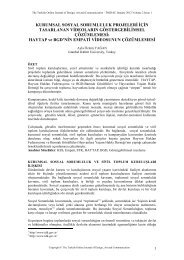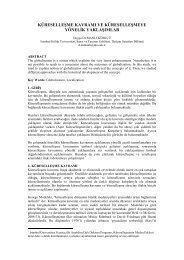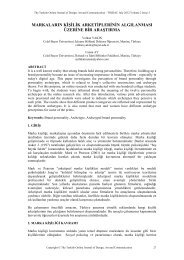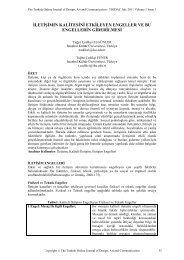aprıl 2012 - tojdac.org
aprıl 2012 - tojdac.org
aprıl 2012 - tojdac.org
Create successful ePaper yourself
Turn your PDF publications into a flip-book with our unique Google optimized e-Paper software.
The Turkish Online Journal of Design, Art and Communication - TOJDAC April <strong>2012</strong> Volume 2 Issue 2<br />
The body is a mediator between reality and sacredness, caught between the two, or better yet:<br />
its material nature becomes sacred when it is directly involved in consciousness. To express<br />
this revelation, new technologies can be a powerful tool, especially digital video image,<br />
because they allow the video-artist to represent the relation between the body and the sacred<br />
through the profundity of light. Bill Viola used a new optical device to represent the idea of<br />
resurrection of the body in a transcendental way. In “Ocean Without a Shore” (2007), just as<br />
reality is more connected to experience than to knowledge, it is the image of the body that<br />
brings the unknown realm of death into our reality, through its transfiguration (Fig. 1). The<br />
body, which is not material in the first, finds its materiality through light in the second for it<br />
becomes visible in its almost hyper-realistic appearance.<br />
Figure 1. Bill Viola, Ocean Without a Shore, 2007.<br />
In his images, the American video artist creates atmospheres that transform the perception of<br />
time (and space) but at the same time, and through the perception, the presence of the viewer<br />
is reinforced toward the work of art. Bill Viola shows that if knowledge, that is a western<br />
concept, illuminates us, and makes reality perceptible and intelligible, mystery allows us to go<br />
further, to an unknown place where we can discover something new. The endlessness of<br />
mystery leads us to infinite discovery and contact with something new. Video art gave a new<br />
energy to the image through the representation of movement but also of time. It’s not like a<br />
painting that remains the same throughout time: when a video ends, it no longer conveys life.<br />
It’s its visibility and experience that are at stake. Bill Viola asks himself why do we exist at<br />
the same time inside our body and outside from it. His work is based on this tension, between<br />
the external image of the body (and its sensations) and the internal world (rational and<br />
emotional). That is why he says that his work is about “the realism of emotions and<br />
sensations, perceptions or experiences (…) realism of the perceptions of the objects, not of the<br />
object in itself” [1].<br />
In contemporary cinema, the representation of the fall refers to consciousness and to the<br />
ordeal of human condition. It places the human in a regressive state and leads to disorder: it<br />
provokes chaos. The fall can also help one to experience humility through consciousness of<br />
human finitude, with ultimately a desire of being saved [2]. More and more, it is reality that is<br />
summoned by the cinema for it is through life experience that directors strive to approach and<br />
question the world. No artifice, just reality in and of itself. Cinematographic social realism<br />
(that is not exactly Bazin’s realism) allows a meeting between the image and the intimate<br />
Copyright © The Turkish Online Journal of Design, Art and Communication 18









